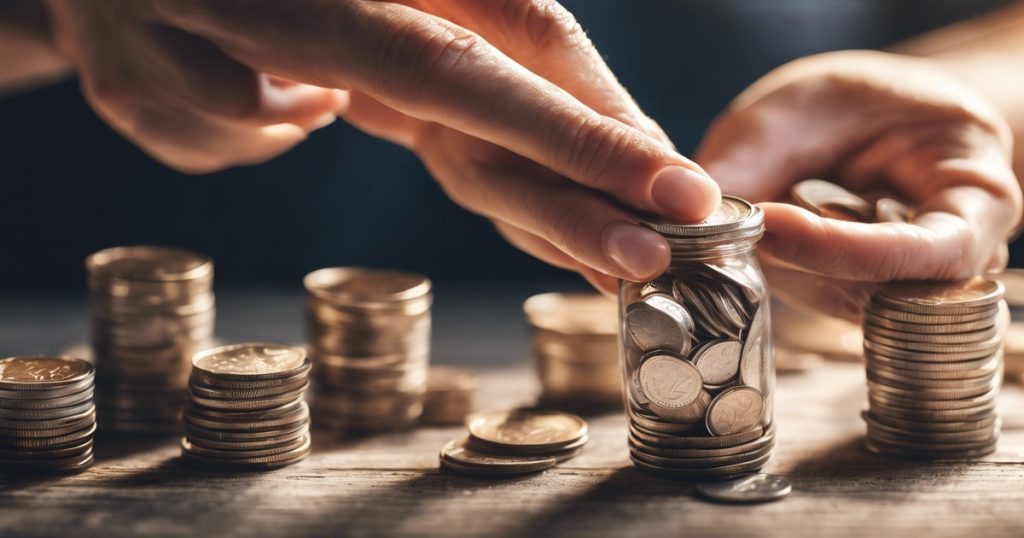Did you know that nearly 800,000 Americans file for bankruptcy each year, often due to poor financial habits? If you find yourself in this situation, rebuilding your savings and managing irregular expenses may seem like an overwhelming task. But fear not, with the right strategies and mindset, it is possible to bounce back stronger than ever.
Key Takeaways
- Organize your post-bankruptcy documents: Keep all important paperwork in order to track progress and stay on top of your financial situation.
- Initiate a savings strategy: Start small and gradually increase your savings to rebuild your financial cushion after bankruptcy.
- Budget wisely: Create a realistic budget that prioritizes essentials and allows for savings to grow steadily over time.
- Rebuild credit carefully: Use secured credit cards and timely payments to slowly improve your credit score post-bankruptcy.
- Monitor your credit reports regularly: Stay informed about your credit status and address any discrepancies promptly to avoid setbacks.
- Prioritize stability: Focus on creating a stable financial foundation by saving, budgeting wisely, and setting achievable financial goals.
Understanding Bankruptcy
Basics Explained
Bankruptcy is a legal process that helps borrowers, individuals, or businesses eliminate or repay debts under the protection of the federal bankruptcy court. Rebuilding savings after bankruptcy involves creating a new financial plan to regain stability. Key terms like Chapter 7 and Chapter 13 are crucial in understanding the bankruptcy process.
Impact on Finances
After filing for bankruptcy, individuals often face significant financial challenges, including cash and money issues. Rebuilding savings post-bankruptcy requires careful budgeting and wise financial decisions. Credit scores may take a hit due to bankruptcy, affecting future loan approvals and interest rates. Financial stability can be compromised, making it essential to focus on rebuilding savings steadily.
Recovery Timeline
The timeline for recovering savings post-bankruptcy varies for each individual. Initially, focus on creating a realistic budget and cutting unnecessary expenses. As time progresses, prioritize building an emergency fund to avoid future financial setbacks. Patience and persistence are key during this recovery journey as it may take years to fully rebuild savings.
Organizing Post-Bankruptcy Documents
Save Paperwork
Properly organizing and saving bankruptcy-related documents is crucial for your financial recovery journey. Maintaining these records can help you stay organized and on track with your finances. It’s essential to keep all paperwork in a safe and secure place to avoid any loss or damage.
To facilitate your financial recovery, consider creating both digital and physical copies of all bankruptcy documents. Store these copies in a secure location such as a locked filing cabinet or a password-protected folder on your computer. By having easy access to these records, you can quickly refer back to them when needed.
Importance of Records
Accurate financial records are key post-bankruptcy as they allow you to track your progress and make informed decisions. These records serve as a roadmap for your financial journey, helping you identify areas where you can improve and grow financially. By maintaining detailed records, you can demonstrate responsible financial behavior and build credibility with lenders.
Keeping track of your expenses, income, debts, and savings post-bankruptcy is essential for monitoring your financial health. Regularly reviewing these records will give you insights into your spending habits and enable you to make adjustments accordingly. Having well-organized records can simplify the process of applying for credit or loans in the future.

Initiating Savings Strategy
Start Saving
Begin saving immediately after bankruptcy to regain financial stability and security. Implement small, consistent savings habits to rebuild your finances effectively. Gradually increase savings contributions over time for long-term financial health.
Creating a budget is crucial in kickstarting savings. Allocate a portion of your income towards savings each month, no matter how small. Consider automatic transfers to a separate savings account to ensure consistency in saving efforts.
Initiating a side hustle or finding ways to increase income can also aid in boosting savings post-bankruptcy. Explore part-time gigs or freelance work opportunities to supplement your primary income source. Utilize any windfalls or bonuses towards your savings goals for accelerated progress.
Open Savings Account
Selecting the right savings account is essential for effective money management post-bankruptcy. Look for accounts with low fees and high interest rates to maximize your savings growth potential. Consider online banks that often offer better interest rates compared to traditional brick-and-mortar institutions.
Segregating your savings from regular checking accounts helps in avoiding unnecessary spending. Having a dedicated savings account creates a clear boundary between funds meant for immediate expenses and those earmarked for future goals. This separation promotes disciplined saving habits.
When choosing a savings account, prioritize those that offer features like overdraft protection, easy access to funds, and no minimum balance requirements. Compare different options from various financial institutions to find the one that best aligns with your saving objectives.
Budgeting After Bankruptcy
Build a Budget
Creating a post-bankruptcy budget is crucial for rebuilding savings effectively. Start by listing all sources of income. Then, outline essential expenses such as rent, utilities, and groceries. Prioritize debt payments to avoid falling back into financial distress. Ensure your budget is realistic and flexible to adapt to unexpected expenses.
To create a post-bankruptcy budget, first, list all sources of income. Next, identify essential expenses like rent, utilities, and groceries. Prioritize debt payments to prevent further financial strain. A realistic and flexible budget allows room for unexpected costs.
When building a post-bankruptcy budget, list all income sources first. Then, identify necessary expenses like rent and groceries. Prioritize paying off debts to avoid worsening financial situations. Maintain a flexible budget to accommodate unforeseen expenditures.
Expense Tracking
Tracking expenses diligently is vital in the post-bankruptcy phase to manage finances efficiently. Utilize tools like expense tracking apps or spreadsheets to monitor spending closely. By analyzing your expenses regularly, you can identify patterns and make adjustments to align with your budget goals.
In the post-bankruptcy phase, monitoring expenses diligently is crucial for financial management. Use tools such as expense tracking apps or spreadsheets for accurate tracking. Regularly reviewing your spending helps in recognizing patterns and making necessary adjustments.
For effective financial management after bankruptcy, track expenses meticulously using tools like apps or spreadsheets. Analyzing spending habits regularly helps in understanding patterns and making informed decisions about budget adjustments.
Reestablishing Credit
Pay Bills Timely
After bankruptcy, timely bill payments are crucial for rebuilding credit and financial stability. Missing payments can further damage your credit score and hinder progress. Setting reminders or automating payments can help maintain punctuality.
Punctuality plays a vital role in credit score improvement post-bankruptcy. Late payments reflect negatively on your financial reputation and creditworthiness. Consistent on-time payments demonstrate responsibility and reliability to creditors.
To ensure timely bill payments, consider setting up reminders on your phone or using calendar alerts. Automating payments for recurring bills can prevent forgetfulness and improve punctuality. These simple steps can significantly impact your credit rebuilding journey.
Secured Credit Cards
Secured credit cards are viable options for rebuilding credit after bankruptcy. By providing a security deposit, these cards offer a fresh start to establish responsible credit behavior. Using secured cards wisely can boost your credit score over time.
The benefits of secured credit cards include accessibility for individuals with poor credit history and the opportunity to demonstrate financial responsibility. However, it’s essential to monitor spending closely and avoid accumulating debt beyond the limit.
Responsible usage of secured credit cards involves paying balances in full each month and keeping credit utilization low. By practicing good habits, you can gradually rebuild your credit score and regain financial stability.
Utility Bill Reporting
Utility bill reporting can have a significant impact on credit history post-bankruptcy. Timely payment of utility bills demonstrates reliability to creditors and positively influences your credit score. Ensuring that utility bills are reported to credit bureaus is essential for accurate credit assessment.
By prioritizing on-time utility bill payments, you showcase financial responsibility and enhance your credit profile. Consistent payment history reflects positively on your overall creditworthiness and helps in the process of rebuilding your financial standing.
To guarantee that utility bills are reported accurately, communicate with service providers about reporting practices to credit bureaus. Being proactive in this aspect ensures that your responsible payment behavior is reflected in your credit report.
Credit Builder Loans
Credit builder loans serve as effective tools for credit repair post-bankruptcy. These loans allow individuals to establish or rebuild their credit history through regular payments towards a savings account or certificate of deposit (CD).
The features of credit builder loans include structured repayment plans, low-risk borrowing, and the opportunity to boost credit scores gradually over time. Selecting reputable lenders offering these loans is crucial for a successful rebuilding process.
Guidance on choosing trustworthy lenders includes researching different institutions, comparing loan terms, and understanding all associated fees before committing to a specific lender. By making informed decisions regarding credit builder loans, you pave the way towards improved financial health.

Monitoring Credit Reports
Regular Checks
Regularly monitoring credit reports is crucial after bankruptcy to track financial progress and detect any discrepancies. Frequent checks help identify errors or signs of fraud early on, allowing for prompt resolution. Accessing free credit reports annually from major bureaus like Equifax, Experian, and TransUnion is advisable. Understanding credit scores and the factors influencing them aids in making informed financial decisions.
Dispute Errors
When it comes to disputing errors, it’s essential to scrutinize credit reports for inaccuracies post-bankruptcy. Identify any erroneous information such as incorrect account details or payment history discrepancies. The process of disputing involves notifying the credit bureau of the error and providing supporting documentation. Following up with the credit bureaus ensures timely investigations and corrections, leading to accurate credit reporting.
Stability in Life
Maintain Job
Securing stable employment is crucial for rebuilding savings after bankruptcy. It provides a steady income stream. To maintain a job, focus on developing strong work ethics and skills. Networking can also help in career advancement.
Enhancing employability post-bankruptcy is essential. Consider upgrading skills through online courses or certifications. Increasing income sources can aid in saving more money each month.
Secure Housing
Securing housing post-bankruptcy can be challenging due to credit issues. Look for affordable options within your budget. Stable housing is vital for financial recovery and overall well-being.
Finding suitable housing might require assistance from local agencies or non-profit organizations. Prioritize rent payments to maintain stability and rebuild your financial standing.
Creating an Emergency Fund
Emergency Savings
After bankruptcy, building an emergency fund is crucial for financial stability. This fund acts as a safety net in unexpected situations. Aim to save three to six months’ worth of living expenses.
To gradually grow your emergency savings, start by setting aside a small amount each month. Automate transfers to ensure consistency. Consider opening a separate account for this fund to avoid temptation.
Fund Allocation
Post-bankruptcy, it’s vital to allocate funds wisely. Prioritize building your emergency savings first, followed by debt repayment and essential expenses. Strive to balance short-term needs with long-term financial goals.
When allocating funds, consider creating a budget that outlines your income and expenses. Allocate a portion of your income towards savings and another towards debt repayment. Cut back on non-essential expenses to accelerate the process.
Setting Financial Goals
Short-term Goals
Setting achievable short-term financial goals is crucial after bankruptcy to regain stability. These goals can include saving for an upcoming expense or focusing on debt repayment. By setting these short-term objectives, individuals can maintain motivation and see tangible progress in their financial recovery journey.
Short-term goals act as stepping stones towards larger financial milestones. They provide a sense of accomplishment and keep individuals focused on their financial recovery. For instance, saving a specific amount each month for an emergency fund can help build a financial safety net.
Examples of short-term goals post-bankruptcy may involve creating a budget, tracking expenses diligently, or paying off small debts. Each achievement in these short-term goals boosts confidence and reinforces positive financial habits.
Long-term Goals
Planning for long-term financial stability is essential post-bankruptcy to ensure sustained financial well-being. It’s crucial to set long-term goals such as retirement planning, investing for the future, and building wealth gradually over time. These objectives lay the foundation for a secure financial future beyond immediate recovery needs.
Long-term goals offer a sense of direction and purpose in one’s financial journey. They encourage individuals to look beyond their current circumstances and focus on building wealth and securing their future. For instance, setting aside a portion of income for retirement savings ensures a comfortable life in the later years.
To achieve long-term financial objectives effectively, it’s important to break down these goals into smaller, actionable steps. This could involve seeking professional financial advice, exploring investment opportunities, or diversifying income sources for long-term stability.
Summary
Now that you’ve navigated the complexities of bankruptcy, organized your documents, and kickstarted your savings strategy, it’s time to focus on rebuilding your financial stability. By budgeting wisely, reestablishing your credit, monitoring your credit reports, and creating an emergency fund, you’re setting yourself up for a brighter financial future. Setting clear financial goals will help you stay motivated and on track towards achieving long-term stability.
Take charge of your financial well-being by implementing the strategies discussed. Remember, rebuilding your savings after bankruptcy is a journey that requires patience and dedication. Stay proactive, make informed financial decisions, and seek guidance when needed. With perseverance and smart money management, you can rebuild your savings and secure a stable financial future for yourself. Keep going—you’ve got this!
Frequently Asked Questions
How long does it take to rebuild savings after bankruptcy?
Rebuilding savings after bankruptcy varies for each individual, but with a disciplined approach, it can typically take 1-3 years to see significant progress. Consistent saving habits and financial planning are key.
What is the importance of creating an emergency fund post-bankruptcy?
Creating an emergency fund post-bankruptcy is crucial as it provides a safety net in case of unexpected expenses or emergencies. Having this fund in place helps prevent relying on credit cards or loans, thus maintaining financial stability.
Can I start setting financial goals immediately after bankruptcy?
Yes, you can start setting financial goals right after bankruptcy. Setting clear and achievable goals will help you stay focused, motivated, and track your progress. It’s essential to align these goals with your current financial situation and long-term objectives.
How often should I monitor my credit reports post-bankruptcy?
It’s recommended to monitor your credit reports regularly post-bankruptcy, ideally at least once every four months. This allows you to track your progress, detect any errors or fraudulent activities promptly, and ensure that your credit information is accurate.
What steps can I take to reestablish credit after bankruptcy?
To reestablish credit after bankruptcy, consider options like secured credit cards, becoming an authorized user on someone else’s account, or applying for a credit-builder loan. Making timely payments and keeping credit utilization low are crucial for rebuilding your credit score.




